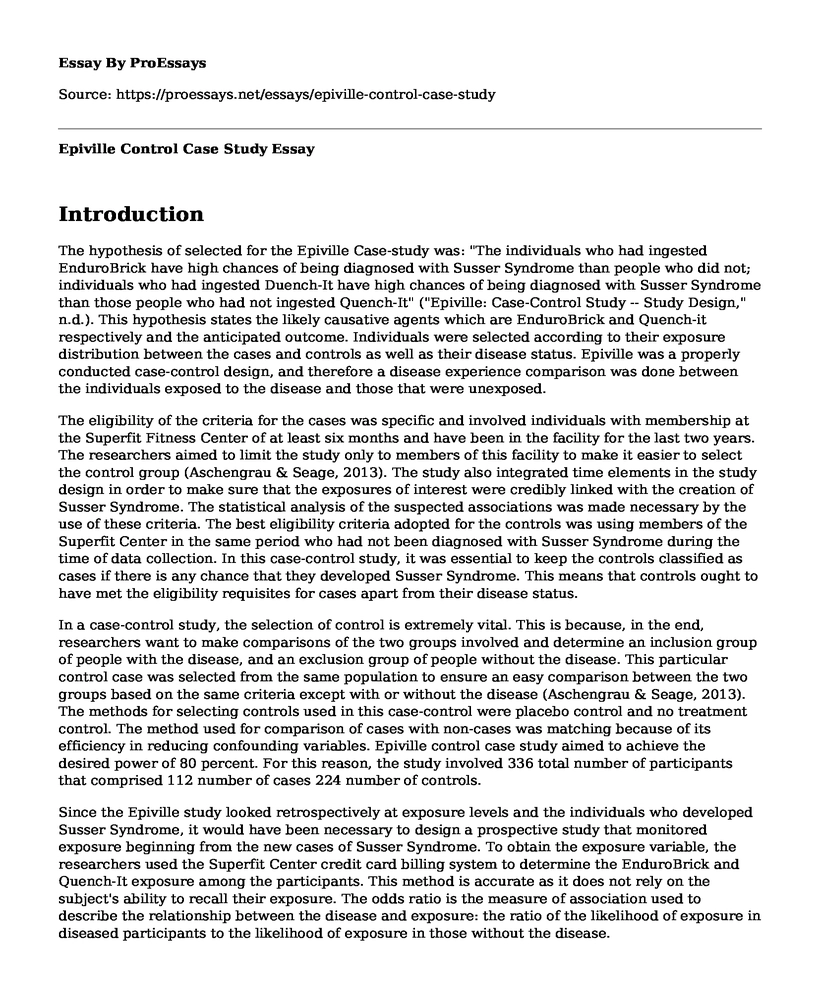Introduction
The hypothesis of selected for the Epiville Case-study was: "The individuals who had ingested EnduroBrick have high chances of being diagnosed with Susser Syndrome than people who did not; individuals who had ingested Duench-It have high chances of being diagnosed with Susser Syndrome than those people who had not ingested Quench-It" ("Epiville: Case-Control Study -- Study Design," n.d.). This hypothesis states the likely causative agents which are EnduroBrick and Quench-it respectively and the anticipated outcome. Individuals were selected according to their exposure distribution between the cases and controls as well as their disease status. Epiville was a properly conducted case-control design, and therefore a disease experience comparison was done between the individuals exposed to the disease and those that were unexposed.
The eligibility of the criteria for the cases was specific and involved individuals with membership at the Superfit Fitness Center of at least six months and have been in the facility for the last two years. The researchers aimed to limit the study only to members of this facility to make it easier to select the control group (Aschengrau & Seage, 2013). The study also integrated time elements in the study design in order to make sure that the exposures of interest were credibly linked with the creation of Susser Syndrome. The statistical analysis of the suspected associations was made necessary by the use of these criteria. The best eligibility criteria adopted for the controls was using members of the Superfit Center in the same period who had not been diagnosed with Susser Syndrome during the time of data collection. In this case-control study, it was essential to keep the controls classified as cases if there is any chance that they developed Susser Syndrome. This means that controls ought to have met the eligibility requisites for cases apart from their disease status.
In a case-control study, the selection of control is extremely vital. This is because, in the end, researchers want to make comparisons of the two groups involved and determine an inclusion group of people with the disease, and an exclusion group of people without the disease. This particular control case was selected from the same population to ensure an easy comparison between the two groups based on the same criteria except with or without the disease (Aschengrau & Seage, 2013). The methods for selecting controls used in this case-control were placebo control and no treatment control. The method used for comparison of cases with non-cases was matching because of its efficiency in reducing confounding variables. Epiville control case study aimed to achieve the desired power of 80 percent. For this reason, the study involved 336 total number of participants that comprised 112 number of cases 224 number of controls.
Since the Epiville study looked retrospectively at exposure levels and the individuals who developed Susser Syndrome, it would have been necessary to design a prospective study that monitored exposure beginning from the new cases of Susser Syndrome. To obtain the exposure variable, the researchers used the Superfit Center credit card billing system to determine the EnduroBrick and Quench-It exposure among the participants. This method is accurate as it does not rely on the subject's ability to recall their exposure. The odds ratio is the measure of association used to describe the relationship between the disease and exposure: the ratio of the likelihood of exposure in diseased participants to the likelihood of exposure in those without the disease.
The results obtained in the study were as follows:
- Cases that ingested EnduroBrick: 28
- Controls that ingested EnduroBrick: 56
- Cases that consumed Quench-It: 50
- Controls that consumed Quench-It: 56
References
Aschengrau, A., Boston University School of Public Health Boston Massachusetts Ann Aschengrau, & Seage, G. R. (2013). Essentials of Epidemiology in Public Health. Burlington, MA: Jones & Bartlett Publishers.
Epiville: Case-Control Study -- Study Design. (n.d.). Retrieved from http://epiville.ccnmtl.columbia.edu/case_control_study/study_design.html
Cite this page
Epiville Control Case Study. (2022, Nov 13). Retrieved from https://proessays.net/essays/epiville-control-case-study
If you are the original author of this essay and no longer wish to have it published on the ProEssays website, please click below to request its removal:
- Safety Plan
- Critical Decision Making for Healthcare Providers
- The Story of an Emerging Public Health Issue: Childhood Obesity in GA
- Blunt Abdominal Trauma in an Infant: Case Study
- Essay on Lincoln Hospital: Creative Solutions Needed to Avoid Life-Threatening Conditions
- Essay Sample on Legal Obligation of Nurses Administering Alternative Medicine
- Essay Example on Achieving Healthy Living: Exercise & Healthy Eating







